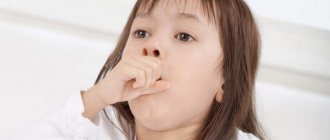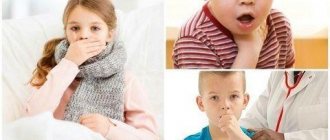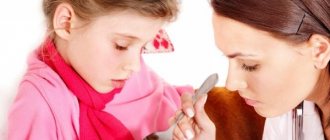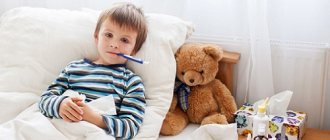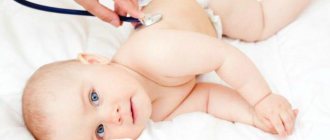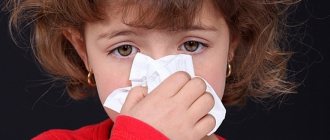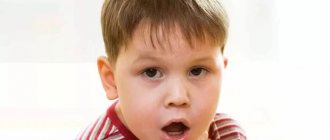A sharp exhalation through the mouth, or cough, is a vital reflex: its task is to free the respiratory tract from foreign substances, including a runny nose.
If a child’s cough from snot recurs regularly, be sure to contact a pediatrician or otolaryngologist.
Especially in infants, rhinitis can lead to unpleasant consequences, like otitis media, or cause more serious harm to health. Treatment depends on the nature of the attacks and accompanying symptoms.
First, let's determine the source of the cough and runny nose.
ARVI ranks first among provocateurs. This is a group of diseases with similar symptoms. It spreads through airborne droplets and affects children's respiratory organs. Finding exactly the virus that caused the illness is problematic; there are more than 200 of them.
Other symptoms of ARVI besides cough and runny nose:
- sneezing;
- swelling of the mucous membranes;
- hard breath;
- muscle and headache;
- temperature;
- general weakness.
The flu adds severe headaches and a sore throat to the list. Rhinitis does not cause a high fever and does not put the child to bed, but it can be a signal for examination for measles and diphtheria. Laryngitis is characterized by a rough cough, hoarseness, the larynx becomes covered with crusts and mucus. Bronchitis provokes a deep, dry or wet cough.
Sore throat requires serious treatment; it can cause heart complications. It is identified by acute inflammation in the throat area - a white or gray coating. Pharyngitis, tracheitis, bronchiolitis, sinusitis, sinusitis and, most importantly, pneumonia, also require medical supervision.
The next pests are bacteria. Tests show the presence of a bacterial infection; it is expressed by severe pain, green snot and sputum. But yellow-green snot indicates the release of dead immune cells. A runny nose and cough can be a reaction to pollen, pet dander, and other irritants. Signs of allergies include severe lacrimation, itching in the nose and eyes.
Cough due to snot in a baby
Despite the fact that colds are present in our lives periodically, they can be dangerous for infants. It is necessary to fight them, but you should not eliminate only the symptoms, you need to eliminate the cause of the disease itself. Therefore, the doctor prescribes complex therapy to combat rhinitis and cough.
Causes and types of rhinitis
A runny nose is usually accompanied by sneezing, itching and discharge, which are divided into the following types:
A baby may develop a cough and runny nose for the following reasons:
- penetration of viruses or bacteria;
- allergy;
- inflammatory process in the sinuses.
It all starts with swelling in the nose, when it becomes difficult for the baby to breathe and the nose becomes clogged.
- Infectious. This type of rhinitis is also accompanied by fever and general malaise.
- Allergic rhinitis is manifested by lacrimation, itching in the nose, liquid transparent nasal discharge, redness of the eyes, and conjunctivitis.
- Atrophic.
Develops after long-term use of vasoconstrictor drugs. - Vasomotor. It often affects young children who have had ARVI. This type can quickly turn into an atrophic form.
Symptomatic manifestations
Cough and runny nose in infants are also symptoms of various diseases. They may appear along with other accompanying symptoms:
- increased body temperature;
- difficulty with nasal breathing;
- nasal discharge;
- sneezing.
These signs may be present in whole or in part. Sometimes an infant only has a runny nose and coughing. Due to nasal congestion and cough, which exhaust the baby, he becomes whiny, moody, and restless.
Measures to combat a runny nose
As soon as parents notice that the baby has a stuffy nose, they should immediately try to eliminate this problem. Since with a stuffy nose, he will not be able to sleep normally, much less suck a breast or bottle.
How to treat a runny nose? Treatment of a runny nose:
If the cough occurs due to a runny nose, that is, when mucus flows down the back wall and irritates its mucous membrane, then after the runny nose stops, the cough will go away on its own.
Treatment of cough in infants
You will have to use other methods of treating cough in infants:
If a child is sick and coughing, it is necessary to follow a feeding schedule. The interval between feedings should be such that the digestive organs are able to sufficiently digest the incoming food.
Some mothers, in order to calm a sick baby, give him breastfeeding. But you shouldn’t do this, as excessive food intake into the gastrointestinal tract will overload it, and recovery will be delayed.
To completely get rid of a runny nose and cough, you must first determine the cause of their occurrence. Since each disease requires special treatment. So, if you have allergies, you will have to give your child antihistamines. The allergen is identified. For viral infections, antiviral agents are needed. When bacteria penetrate in severe cases, antibiotics cannot be avoided.
What not to do?
Massage is done only after body temperature has returned to normal. It can be used over the next month, even if recovery has already occurred. In this way you can strengthen the child’s body.
After the massage, you can bathe the baby in a bath with the addition of medicinal herbs. When wondering how to treat a baby’s cough and runny nose, you also need to remember that the treatment must be comprehensive.
By eliminating only the symptoms, you cannot cope with the disease.
//nosgid.ru/bolezni/nasmork/i-kashel-u-grudnichka
How can you cure a child’s cough from snot?
The answer from experts is approximately the same: first of all, you need to get rid of snot from the baby, otherwise any cough medicine will not bring results.
Why does mucus in the nose cause people to cough?
So, first of all, parents are obliged to create maximum outflow from the nasal sinuses, especially in infants. But only in such a way that the pathological contents begin to be released into the external environment, and not inside the body.
Also, after a careful examination, the doctor may prescribe medication depending on the type of cough:
- for dry conditions, sputum thinners are used;
- when the sputum has already begun to leave, this is called a wet cough, at which time expectorants are prescribed.
Which remedies are most effective?
- Bromhexine syrup.
It is allowed even for infants and is taken 2 mg three times a day. For a child over two years old, the dose is doubled, and over 6 years old – four times. Children's medicine is used up to 14 years of age, although usually at this age it is not necessary to treat a cough caused by snot, because you can already cough and get rid of phlegm. - Gerbion syrup is perfect for children's bodies due to its plant components.
The main active ingredient is plantain, but infants cannot be treated with this drug. It is prescribed from two years of age, 1 measuring spoon three times a day. For children over 7 years old, the dose is doubled.
Next, you should focus on another group of drugs that accelerate the discharge of sputum from the bronchi. Most often, they try to treat a wet cough with the following means:
We treat ailments with inhalations
In addition to this treatment, a child’s cough after snot can be treated using inhalations. It is a proven fact that warm steam quickly helps to get rid of such an ailment and thins the mucus that flows down the back wall of the throat.
I would like to point out that a child’s snot during a runny nose can be of different consistency. For example, if the discharge is liquid, it is important to promptly wipe it with a handkerchief and clear the nose of the abundance of pathological secretions.
If a child has thick snot, the first priority of treatment is to bring it into a liquid state.
Usually at this time nasal breathing is difficult, so thick snot is softened with saline or saline solutions, after which the nose is also cleared so that excess mucus does not drain into the bronchi and provoke a cough.
How to help a baby without medications?
It is especially important to provide your child with plenty of fluids. These can be herbal decoctions, fruit drinks and teas, compotes, uzvars. Particularly useful are drinks rich in vitamin C, which will not only saturate the body with life-giving fluid and promote the removal of secretions, but also favorably support the immune system in the fight against the root cause of the runny nose.
General rules for treating a child for cough and runny nose
If a child is sick for the first 3 days and no serious symptoms are detected, we will help him cope with his illness in simple ways. This is enough to overcome a common ARVI and prevent complications from a more serious illness.
We organize suitable conditions for the child:
- The optimal air temperature in the room is 18-22 degrees.
- We regularly ventilate the room.
- We do wet cleaning 2-3 times a day. We remember that viruses and bacteria like to live in dust.
- We humidify the air the child inhales with a humidifier or a simple wet towel on a radiator.
- We do not force the child to eat, but we insist on drinking plenty of any liquids: tea, fruit drinks, mineral water, compotes.
If the child feels well, we go for walks more often. We try to prevent the mucus in the nose from drying out and crusts from forming. The ideal assistant for this is a weak salt solution, which can be purchased at a pharmacy (saline) or made independently (1 teaspoon of salt per liter of water). It is absolutely harmless, it is permissible to drop 2-4 drops into each nasal passage at least an hour later.
It is appropriate to add an oil solution to the salt solution - Vaseline, olive oil, tocopherol, retinol or “Ectericide”. It will coat the mucous membranes and prevent drying. The oily liquid must be combined with hydrochloric liquid; the former can be dripped less frequently - every 2 hours.
Do not use vasoconstrictor drops - Naphthyzin, Nazol - to get rid of a common viral runny nose. They first alleviate the condition, and then worsen it, dry out the mucous membranes and cause complications in the medical history. They are appropriate for allergic rhinitis and otitis media.
Get tested for allergies. If a child’s rhinitis is caused precisely by external irritants, remove the source, start taking antihistamines and vasoconstrictor drops. The correct therapy should be prescribed by a pediatrician. Drops should not be used more than 3 times a day or longer than a week.
Let’s summarize the entire comprehensive approach to combating the runny nose:
- Drink plenty of any liquids that the child does not refuse - water, tea, compote, diluted juices.
- Give your son or daughter vitamins. In some cases, it is permissible to use antiviral drugs that stimulate the production of interferon and help fight viruses.
- Create all the conditions for recovery, let the child breathe clean and cool air.
- Moisten the nasal passages with a saline and oil solution, clear them of mucus.
- Apply an aroma lamp with esters - clove, eucalyptus, cinnamon, mint oil, diluted in a base of apricot, peach or jojoba oil. You can anoint the wings of the nose and the bridge of the nose with the mixture if the baby does not resist. An old proven method is the “Star” balm.
The mucous discharge from the nose should flow. Use an aspirator (nozzle suction device) or cotton swabs if you have a baby. It’s better to have irritation from a handkerchief under the nose than for a child to need long-term treatment in a hospital setting. If you follow these simple recommendations, a runny nose and cough (as a result of snot) will go away on their own in just 3 days.
The baby has a severe cough and runny nose
Colds are often diagnosed in childhood and especially in infants. The main reason for the appearance of cough with runny nose in children under one year of age is the clearance of various contaminants from the respiratory tract, which is considered normal.
In older children, cough, runny nose and fever become the main signs of the development of colds in the body. In some cases, the disease occurs without fever and this can happen for various reasons. What should parents do if their child has a cough and runny nose without fever, and what treatment methods should they prefer?
Reasons for the development of pathology
The presence in a child of a cough with a runny nose without fever is a sign of an incipient cold or allergy
The main signs of a cold, which can occur when various viruses enter a child’s body, are a runny nose and cough. The baby’s immune system begins to react to pathogenic microorganisms and enter into a peculiar reaction with them.
However, in some cases, problems arise with recognizing the virus and it easily penetrates into the cells of the body. If a bacterial disease develops, an increase in body temperature is immediately noted, but with a viral infection, the indicators remain normal.
In the absence of effective treatment for viral rhinitis, the risk of developing a severe inflammatory process in the sinuses increases, that is, sinusitis develops.
Parents need to understand that pathogenic microorganisms may enter the throat and trachea area.
In such a situation, in the absence of effective treatment, complications may develop in the form of:
The penetration of various viruses into the child’s body significantly disrupts the functioning of the immune system, so the course of such a disease can be supplemented by a bacterial infection. With ARVI, other pathogenic microorganisms present in the child’s body are also activated, which leads to the development of an inflammatory process in the ENT organs.
Parents need to understand that even in the absence of fever with a cough and runny nose, it is imperative to show the child to a specialist who will find out the causes of this condition and prescribe effective treatment.
— Cough in children: causes, types and treatment
In some cases, the cause of cough and runny nose without fever may be the development of allergic rhinitis. Most often, this pathology is diagnosed in children and adults who spend a long time in a dusty room.
Allergic rhinitis can occur as a reaction to chemicals, pollen, children's cosmetics and animal dander.
In some cases, even healthy children may experience a runny nose and cough without fever due to too dry air in the children's room.
If a cough and runny nose without fever bother a child for a long time, this may be a dangerous signal. An allergic reaction can lead to the development of such a complex disease as bronchial asthma. It is for this reason that it is necessary to show the child to the doctor in time, which will avoid the development of many complications.
Drug treatment
It is important to remember that in childhood it is necessary to use various medications only after consultation with a specialist.
To combat a viral infection, antiviral drugs are usually used, since without their help it is unlikely to achieve a positive result.
- The following drugs have a good effect in the treatment of viral diseases: Ingavirin, Remantadine, Isoprinosine, Ribavirin, Arbidol.
- Such antiviral drugs can be used in children from the first day of their birth. In order to activate the body's strength to fight the disease during drug therapy, interferonogenesis inducers are prescribed: Laferon, Cycloferon, Viferon, Anaferon.
- A severe cough and nasal congestion cause children a lot of inconvenience and anxiety, so it is necessary to get rid of unpleasant symptoms. To eliminate nasal congestion and restore breathing, experts prescribe the use of the following medications: Tizin, Farmazolin, Nazivin, Galazolin. It is important to remember that such vasoconstrictor drops are allowed to be used for no more than 5 days, otherwise the risk of developing allergic rhinitis increases. If a child is bothered by a wet cough, treatment should be carried out using medications that help dilute mucus and remove it from the respiratory tract.
- The following drugs have a good effect in the fight against wet cough: ACC, Mucaltin, licorice root tincture.
- If a child is bothered by a dry cough, drugs such as Libexin, Pertussin and Tusuprex are usually used to eliminate it.
- In some cases, a child may suffer from a prolonged cough combined with nasal congestion, but without fever. In such a situation, it is recommended to give the child herbal breast milk, however, this must be done after consulting a doctor. The fact is that such a collection has a suppressive effect on cough, which can disrupt the process of sputum discharge and cause the development of an inflammatory process in the lungs.
- Often a cough and runny nose without fever is a manifestation of an allergic reaction against the background of an inflammatory process in the body. In such a situation, to eliminate tissue swelling and relieve an allergic reaction, the following antihistamines are prescribed: Loratadine, Zaditen, Suprastin, Tavegil.
Traditional methods of treatment
The best folk recipes for treating a runny nose and cough in a child
At home, you can treat a child’s runny nose and cough using folk remedies:
- You can use steam inhalation, when the child inhales the emanating steam from boiled potatoes. To do this, you need to thoroughly wash the root vegetable and boil it. After this, you should slightly tilt the child’s face over the emanating steam, covering himself with a towel on top. He must breathe over the steam for minutes, and this procedure is preferably carried out for older children.
- If a cold is accompanied by a runny nose, then homemade nasal drops can be used to relieve nasal congestion. For this, it is recommended to use medicinal plants such as aloe and Kalanchoe, as well as garlic and onions.
- If parents decide to prepare drops from Kalanchoe, then it is best to use a young plant no older than 3-5 years. The squeezed juice must be diluted with water in a ratio of 1:10 and a few drops of the prepared product should be dripped into each nasal passage. It is important to remember that during treatment it is not recommended to combine aloe juice with medications such as Sanorin and Naphthyzin, since there is a danger of developing sinusitis.
- Inhalations with a nebulizer based on soda and medicinal herbs give a good effect for a productive cough and runny nose. At the moment of inhalation of the medicinal solution, the mucous membrane is moistened and the muscles of the bronchi are relaxed, which allows sputum to easily exit the respiratory tract.
Other therapies
When treating a child with a cough and runny nose without fever, it is recommended to adhere to the following rules:
- it is necessary to maintain optimal humidity in the children's room and this can be done with regular ventilation
- The air temperature in the room should be maintained no higher than 20 degrees
- It is important to organize the child’s drinking regime
- It is recommended to maintain proper and nutritious nutrition, excluding spicy and hot foods from the diet
- During the day, it is fashionable to rinse the child’s nose more often with saline or saline solution
- It is necessary to fill the child’s diet with vegetables and fruits
It is possible to improve blood circulation in the chest area and speed up the discharge of sputum when coughing with the help of warm compresses.
For this purpose, you can use boiled potatoes, honey, flour and vegetable oil. All ingredients are mixed together and the resulting mass is applied to the child’s chest area for several hours.
After time, the compress is removed from the chest and the baby is carefully wrapped.
It is important that during illness the child consumes as much fluid as possible.
You can offer your baby rosehip decoctions, compotes, tea with lemons, cranberry or lingonberry juice. Decoctions of medicinal plants such as oregano, coltsfoot, plantain and thyme provide a good effect in the fight against cough without fever.
It is necessary to treat a child only after consultation with a specialist, since self-medication can further aggravate the baby’s condition and cause the development of many complications. If a child has an allergic runny nose and cough, then, first of all, it is necessary to identify the allergen and completely protect the child from it.
Share with your friends!
Source: //sport-start.ru/u-grudnichka-silnyj-kashel-i-nasmork/
Massage and gymnastics - we will help a child without drugs
Another way to alleviate a child’s condition is acupuncture massage of points on the face. How to do it? Using light, smooth massaging movements, move down from the bridge of the nose from the eyebrows along the wings to the base of the nose and massage the side surfaces of the tip a little more. We act symmetrically on both sides and clockwise.
Breathing exercises will also come in handy. There are different techniques, but even the simplest of them improve blood circulation in the nasopharynx and relieve swelling. It is enough to do breathing exercises 1-2 times a day. It will be an excellent addition to the main treatment.
When a runny nose requires emergency medical attention:
- If the snot does not go away for 10 days or more, you need a consultation and testing for the presence of a bacterial infection. In this case, the doctor will prescribe antibiotics.
- If a child complains of an unbearable headache or discomfort in the ears (for very young children, you can press the tragus to determine whether the ear hurts or not). Contact an ENT specialist to rule out the presence of sinusitis or otitis media. These symptoms may indicate inflammation of the meninges (meningitis).
- If you notice blood in the mucus secreted and it did not get there from the wounds around the nose, plus the child looks too lethargic - these signs indicate diphtheria.
Don't put antibiotics in your nose. They cause an allergic reaction in the body. Later, if antibiotic treatment is needed for a serious illness, they will be useless and sometimes dangerous. The popular “Dioxidin” is completely toxic to children.
Let's move on to coughing - how to get rid of it and is it always necessary to do this?
A cough is the same immune response as a runny nose. By coughing, the child tries to clear the airways of irritants. Most often, this same irritant is snot. And the first way to get rid of a cough is to cure a runny nose using the methods described above.
Any disease of the respiratory tract is accompanied by copious production of sputum. The body removes accumulated mucus by coughing. The parents’ task is not to dry out the mucus and to do everything so that it leaves the child’s body more easily. And the first remedies are plenty of fluids and cool air.
It is strictly forbidden to give a child cough suppressants without a doctor’s prescription.
Pay attention to accompanying symptoms:
- Fever. When a cough and runny nose is accompanied by a temperature no higher than 37.5 degrees, this indicates a cold and does not cause danger. If the thermometer strip runs above 38 degrees, the body is fighting a virus or bacterial infection. Remember that the optimal temperature for the death of viruses is 38-39 degrees; if it rises, you must take an antipyretic. Paracetamol will help check the severity of the disease: if it brings down the temperature, in most cases the disease is mild.
- Labored breathing. It occurs when there is a spasm of the natural air passages and indicates a serious disease of the bronchi, pneumonia.
- Hoarseness in the voice. A bad symptom that requires observation by a doctor. Appears with sore throat, laryngitis, pharyngitis.
If the sputum is very thick, transparent and viscous, you should think about an asthmatic cough. There is no temperature. If the cough is persistent, the sputum is dark and streaked with blood, you need to be examined for cancer.
Folk cough remedies for children
Warm baths with a weak solution of mustard powder will also help eliminate coughing. After the bath, children's feet are rubbed with a warming fatty ointment, and after a couple of minutes socks are put on. You can fill the bathtub with hot water, add a pack of soda and/or salt, and let the child sit in the room and breathe in the steam.
The following recipes also give good results:
- Radish + honey: cut out the center of the vegetable, pour honey into it and leave for 24 hours.
- Onion juice + honey in equal proportions.
- Warm milk mixed with honey and a spoonful of mineral water.
- Half a kilo of walnuts + 300 g of honey + juice of four lemons + teaspoon of aloe juice.
The dosage for small children under 4-5 years old is a teaspoon, from 5 to 10 years old you can give a dessert spoon, from 10 years old - a tablespoon. You need to use the product 2-3 times a day. It is not advisable to treat a child under 3 years of age with folk remedies containing honey; they can cause an allergic reaction.
Time-tested compresses quickly treat a child’s cough:
- Warm boiled potatoes with a few drops of iodine and a spoonful of vegetable oil. The mixture is placed on parchment or plain paper, covered with foil or a bag. The place where the compress is applied is the chest and back. The duration of the procedure is until it cools down.
- A piece of wool soaked in salt water. The amount of salt is a tablespoon per shallow container of water. The compress is placed on the chest and back and left overnight.
- Grind a whole head of garlic with 100 grams of fat or oil. Apply the mixture to your child's feet before bedtime.
Any compress requires wrapping the child. Thermal effects on the chest and feet help to liquefy mucus and promote its rapid removal from the lungs.
Are medications needed to treat a clear runny nose and dry cough in a child?
When the disease begins acutely, you can get treatment without pills and potions. An increased intake of vitamin C, which can be found in citrus fruits and currants, will be beneficial. Give your child orange, grapefruit and currant juice. If necessary, vitamin C can be purchased at the pharmacy. In the first days of illness, interferon drops in the nose are effectively used.
If the baby's body temperature exceeds 38 degrees, an antipyretic drug, for example, Panadol, is needed.
To combat clear runny nose and cough in children, use lightly salted solutions prepared from table and sea salt. You can drip infusions of chamomile and calendula into your nose. When coughing, warm your child with warm milk with honey and butter (put a piece of butter on the tip of a knife). A cough mixture should be selected by a pediatrician, due to the fact that all expectorants have different effects and their own side effects.
To prevent complications, in some cases the doctor prescribes vasoconstrictor drops, for example, nazol, otrivin, tizin, which are used for no more than 5 days. The pediatrician selects the drug according to the age and allergic history of the child.
Before blowing your nose, you must moisten it with drops that are used for treatment.
Viral infections are not treated with antibacterial agents; they are prescribed only for complicated illnesses, when bacterial flora is associated with a weakened immune system. The selection of all antibiotics is carried out only by the attending physician.
Transparent snot and dry cough in a child, with timely treatment, usually go away after 5 days and do not pose any danger. At first they acquire a milky color, and then fade away every day.
How to treat a runny nose in young children
Inhalations are a quick way to relieve a child from coughing
Modern parents are lucky: they have special devices for inhalation at their disposal - nebulizers and inhalers. They will also help cope with cough and runny nose.
The inhaler turns liquid into vapor containing large particles. Use it to moisten the upper respiratory tract and clear phlegm. For inhalation, you can use saline solution, mineral water, herbal decoctions, and oil solutions.
The nebulizer acts as an aerosol, therefore it is used for diseases of the lower respiratory tract. It's better not to use it yourself. The nebulizer is usually loaded with quite serious medications, which are purchased at the pharmacy with a doctor’s prescription.
If you don’t have a special device yet, you can do an old procedure - inhalation with potatoes. Make sure that the steam is not too hot and does not burn the child's airways. The benefits of any inhalation are obvious - they make sputum “wet” and help it leave the child’s body along with viruses and bacteria.
Carry out such procedures infrequently. If the child is small, his cough impulse is not yet fully formed and there is a risk of suffocation from the large amount of mucus secreted.
Treatment of children's cough with medications
Herbal and synthetic mucolytics (“Pertussin”, “Lazolvan”, “Mukaltin”, “Ambroxol”), phlegm-thinning drugs, and syrups containing soda will help ease the child’s well-being with a common cold cough. These drugs provoke the production of sputum and improve its elimination. The composition of the medicines usually includes extracts from licorice root, coltsfoot, and plantain.
There is a second group of medications that block the cough reflex. They are prescribed for dry cough, which appears not only due to viral and bacterial infections, but also due to allergies or neurology. For children, such a drug must be selected by a doctor. It is important to use a mixture or tablets that do not contain harmful components and are not addictive.
Under no circumstances should you give your child drugs from both groups at the same time. By liquefying mucus and muffling the cough, you do not cure, but provoke complications.
What to do if your baby gets sick?
If a newborn baby coughs and his nose is clogged, you should consult a doctor who will make a diagnosis and prescribe treatment. Treating an infant with the same means that are used for adults, for example, vasoconstrictor drops with a high concentration of the active substance, is strictly prohibited!
Such drops can cause a burn to the delicate mucous membrane of the child’s nose, and some cough syrups simply suppress the natural reflex, as a result of which the baby cannot get rid of the mucus accumulated in the respiratory passages.
Infants can react to any, even the “safest” drugs, with allergic reactions and digestive disorders, so treatment should be under the supervision of a pediatrician
You can help your child at home in the following ways:
- buy a humidifier. If this is not possible, you can simply place wet towels on the central heating radiators. It is especially important to humidify the air during the cold season;
- Special gymnastics and massage help to achieve a good result with a wet cough. For example, an effective method of drainage massage is to lightly pat the baby on the back with the edge of your palm. Massage can be done only when the child is without fever;
- the child should be carried vertically in his arms: this will relieve cold symptoms;
- for a dry cough, rubbing the child’s back and chest with special ointments with a warming effect is recommended. You need to choose ointments carefully. The product should not contain dyes and have a strong odor, otherwise the baby may develop bronchospasm or a severe allergic reaction;
- during illness, the child should drink at least 200 ml of water per day. To sanitize the neck, you can give weak chamomile tea. Brew at the rate of 1 heaping teaspoon of dry raw material per 0.5 liters of water, boil for 2-3 minutes, let steep until completely cool, strain through a double layer of gauze. Give the child 5-6 teaspoons of decoction per day to drink, adding the medicinal infusion to lukewarm boiled water. This must be done with caution: some children are allergic to medicinal chamomile;
- You should not put mother's milk in your baby's nose. Many “experienced” women offer this method of treating a runny nose, claiming that mother’s milk helps with any adversity. However, this is not so: sweet milk is an excellent breeding ground for the development of pathogenic bacteria, as a result of which the amount of mucus released only increases;
- A baby's runny nose and cough cause him a lot of suffering. To help the baby breathe, you need to regularly carefully suck out the mucus from the nose using a special aspirator, which is a small bulb with a soft rubber tip;
- Walk in the yard only if the baby feels well, and the temperature outside is above zero and there is no wind. You shouldn’t overheat your baby either, so it’s better to avoid excessive wrapping.
We will do everything to prevent cough and runny nose.
The main preventive measure is strengthening the immune system. An immunogram will help you find out about specific problems in this area. But even without it, there is something to do: hardening, proper nutrition, regular and long walks in the fresh air, sufficient time for sleep and rest. If there is an allergy, analyze what the child reacts to with a runny nose and cough, remove the irritating factor.
The use of some traditional and official medicine will help to avoid the disease: wearing a gauze bandage during the period of virus activity, applying antiviral ointments to the nasal passages, inhaling essential oils.
If you liked the article, please share it:
